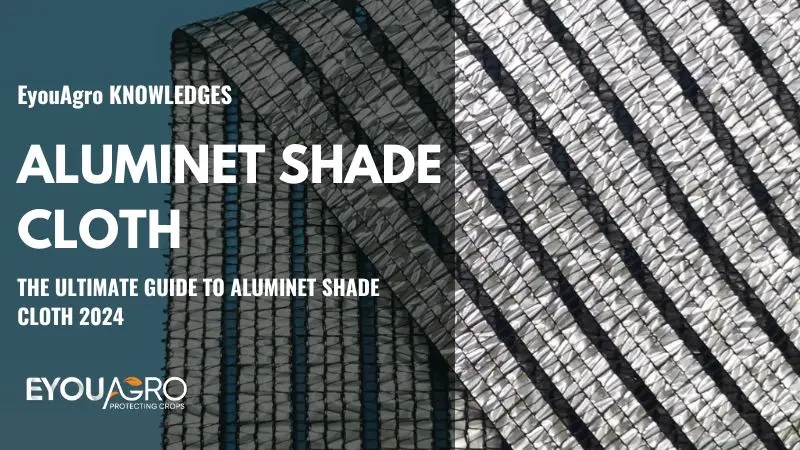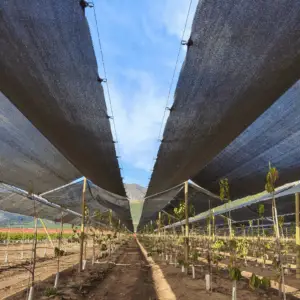Introduction
While cultivating plants, there are two vital actions. Monitoring air and leaf temperature is essential for quality.
The climate in a greenhouse helps plants not only to survive but to develop quickly.
The problem occurs in the summer: it becomes too hot due to a greenhouse’s purpose to trap the sun’s energy and heat.
The gardener and plants are under stress because of hotness, plus plants are dying.
That is easy to avoid by controlling the volume of sunlight to which plants are displaying.
That way, we need an Aluminet shade cloth.
What is Aluminet Shade Cloth?

Aluminet Shade Cloth is a product made of a thin, transparent polyester film combined with an aluminum foil strip.
This reflective sun shade material reduces water loss up to 60% by providing maximum shading for crops.
With canopy temperature reduced by 8°-10°C, crop yield can be improved by creating a healthier environment for yield-critical plants, such as specific flowers, vegetables, and fruits.
So the Aluminet is the best choice for greenhouse cloth.
Aluminet shade cloth is available in 300 denier polyester mesh material which is the ideal choice when durability is needed.
It is intended to shade plants, fruits, and trees from sunlight while still allowing plenty of light to reach the plant so they can grow.
The knitted ones come in various weights and strengths. That includes UV-stabilized polyethylene covers, netting, and aluminum shade cloth.
The purpose is to block a percentage of light from entering the building, which is why it is used to keep plants healthier.
The densities of cloths extend from 30% to 90%.
The variation helps meet the individual demands of various plants, flowers, and crops.
Shade cloth is used for both general and commercial gardening, farming, and greenhouses. It also prevents water from evaporating to keep the plants hydrated.
What is the difference between Black Shade Cloth and Aluminet Shade?

Black shade cloth and aluminet shade netting both have the performance of shading.
However, the screed shade netting made of black shade cloth is woven using special weaving machines to form high-density polyethylene knitted mesh with a specific mesh size (e.g., 0.9–1.2mm).
The process to produce Aluminet Shade Cloth is cutting, bending, and rolling the aluminum foil strips.
Black shade cloth and aluminet shade cloth are different in technology, material, and performance.
- On one hand, the black shade netting can absorb the heat.
- On the other hand, the aluminet shade cloth reflects the heat.

As you can imagine, The Aluminet Shade Cloth is easier to cool down a greenhouse when you build it with shade cloth. Also, aluminet shade cloth is able to reflect more heat when light passes through it than black shade cloth, so it will let plants gain more benefits and be healthier on hot days.
But which one is better?
There are three primary benefits in choosing aluminet.
Reflecting the heat.
Aluminet doesn’t absorb the heat but reflects it. Black absorbs the sun’s rays.
When black shade cloth is in use, the net absorbs radiation, resulting in a hotter temperature. Aluminet works opposite. It reflects radiation away from the net, which results in lower temperatures.
The amount of brightness.
The net of black shade cloth will absorb rays of daylight coming from various low angles.
On the other hand, the aluminet’s reflectivity will allow much of this low-angle light to pass through, which is crucial.
The reason is that the upper leaves receive excess light from direct sunlight, and the lower ones don’t. With diffused light, the light scatters smoother throughout the object.
Thermal Blanket
The plants and floor in a greenhouse give off invisible heat radiation at night. Aluminet, when the gardener installs it, works as a thermal blanket. Also, it reflects this radiation to the plants, maintaining warmer leaf temperatures. This process decreases condensation on the leaves. At the same time, it helps to keep warmer air temperatures within the construction.
That is to say, the Aluminet shade cloth is more effective than the black shade cloth.
But either way, they are more than useful.
Aluminum foil net also has a heat preservation effect.
It is important to remember that there is a light-slow emission effect after adding a transparent film.
Otherwise, black cloth could be the preferred choice as it is more affordable.


The Advantages of Aluminet Shade Cloth
Aluminet effectively reduces temperatures by up to 10°F and can be used as a wind blocker in cold weather.
This silver shade mesh has been used to protect greenhouse crops, shade animals and livestock, cool greenhouses and structures, and control light pollution in observatories.
Dr. Daniel H. Willits has studied at North Carolina State University (NCSU).
According to him, black shade provides little thermal improvement in the greenhouse.
In contrast, aluminet shade cloth results in redecing heat radiation and keeping greenhouse temperatures well.Dr. Willits also reported that reflective materials decrease 30% heat radiation in botanical-garden.
Compared to that, black shade cloth has a 60% shading level without the function of keeping heat radiation.
This process turned to significant reductions in leaf/greenhouse temperature.Of course, it increases a greenhouse’s productivity potential.
The customers’ testimony, which was added to the study, claimed that Aluminum cloth is making double the improvement compared to dark fabric.
As they state, the benefits of Aluminet cover:
- Regulation of day and night temperatures.
- They allow microclimate control, which is a charge of air movement.
- It gives selected diffused light transmission to the crops.
What color of shade cloth is the best?

The spectrum of colors used for shade cloth is broad: black, green, white, red, yellow, and blue. The most frequent ones are black and green.
On the other side is an Aluminet shade cloth, a particular type of material.
Choosing the right color is far more than a simple matter of personal preference. It also depends on the plants’ type and the usage scenario.
White shade cloth is often used for flowering plants.
The reason is the capacity of the white fabric to reduce the quantity of light. At the same time, it doesn’t reduce the quality of the light spectrum.
All this results in rapid growth.
However, red can serve specific plants by clarifying various wavelengths of light.
Dark color shade (black and green) cloth can absorb the sun’s radiation.
The ability to absorb means it behaves like a filter, depriving the plants of sunlight.
Black shade cloth is commonly used as a ground cover to reduce weed growth.
Because black absorbs more heat, it can also be used in winter to help keep the soil warm by blocking frost from penetrating the ground. They are also used as windbreaks or privacy fencing in gardens and farms.
Aluminized shade fabric also contributes to the extra cooling impact for plants.
The aluminet shade cloth reflects 80% of solar radiation while allowing 20% of light transmission. Aluminet is often used under plastic film mulch or on a greenhouse roof,it is a shade for a greenhouse.
By replacing a black or dark-colored shade with a reflective shade, you could:
• choose the same shade and gain less heat gain,
• choose a lower level of shading and profit from higher PAR light transmission.
2 Types of Aluminet Shade Cloth
As the weather cools, it’s important to keep your plants warm.
With potentially frosty nights on the horizon, it’s important to protect your plants from any damage that could occur during a cold snap.
Luckily, aluminet shade cloth is here to help.
During the day, aluminet shade cloth reflects harmful UV rays away from your garden and greenhouse without sacrificing natural light or heat.
At night, though, this same material can insulate your garden and trap heat inside, protecting your plants from frost and helping them thrive in winter.

There are two types of aluminet shade cloth available: Aluminet ‘0’ and Aluminet ‘I.’
Aluminet ‘O’ is for outdoor applications, while Aluminet ‘I’ is for indoor purposes.
Note that no matter for this mark, both have been used outdoors for years.
Also, the knit pattern of Aluminet’ O’ has far more stretches than ‘I’ products.
Either of the variations has flexibility, brightness, strength, and easiness to spread.
The variation in percentage lets various amounts of sunlight enter.
It means that the rate of shade cloth you pick prevents the same part of the sun.
Hence, what you grow will help define the division of shade cloth you need.
Another essential aspect of choosing the correct density is the area where you live.
In other words, the shade cloth should be responding to the local climate.
For hotter places a more solid higher percentage of shade cloth.
Aluminet ‘O’ Minimal Shade Net- Shade Percentage 30%

This model is ideal for minimal shading. Its net can be used to cover constructions, or it can be spread as a ceiling below a greenhouse roof or mobile thermal protection.
The diffused light transmission is 79%, while the size is up to 32 ft (10 m).

Aluminet’ O’ Minimal Shading for External Coverage- Shade Percentage 40%
It is excellent for minimal shading.
The model is mainly for external coverage of shade houses.
It covers tunnels and links spreading above the plastic covering of greenhouse roofs.
It is available with drawstrings for suspended installations and movable screens.
The diffused light transmission is 70%, while the size is up to 32 ft (10 m).
Aluminet ‘I’ Greenhouse Shade Cloth- Shade Percentage 40%
Primarily, the design is for internal use.
It can stay permanently as a ceiling under greenhouse covers.
Also, it is possible to install it as a moveable thermic screen.
The pattern comes with movable screens and drawstrings for recessed installations.
The diffused light transmission is 72%, while the size is up to 27.5 ft (8.4 m).
Aluminet ‘O’ Moderate Shade for External Coverage- Shade Percentage 50%
Fifty percent shade cloth for plants is for the outside cover of constructions.
It is also used for joint spreading on plastic screening greenhouse roofs.
It is efficient for energy conservation in winter.
The diffused light transmission is 60%, while the size is up to 32 ft (10 m).
Aluminet ‘I’ Greenhouse Shade Cloth- Shade Percentage 50%

The model is for internal use.
However, it is also spreadable like a ceiling underneath the greenhouse roof.
You could even establish it as a moveable thermic cover.
The diffused light transmission is 65%, while the size is up to 27.5 ft (8.4 m).
Aluminet ‘O’ Dense Shading for Poultry/Cattle/Fish-breeding- Shade Percentage 80%
The product is used to protect/cover tunnels and shade houses.
It is also intended to be linked to spreading above the plastic covering.
The purpose of a plastic covering is to protect the greenhouse roof.
It is often used in poultry/cattle/fish-breeding installations.
The diffused light transmission is 32%, and the size is up to 26 ft (8 m).

FAQs for Aluminet Shade Cloth
Conclusion
No matter which shade cloth you pick, you will have benefits. The award you receive is reducing both energy and water costs. It also gives you more pleasant work and healthier plants.
Optimize Your Growing Conditions with Aluminet!
Aluminet shade cloth provides excellent heat reduction and light diffusion, making it an ideal solution for improving your crop yield. At EyouAgro, we offer top-grade Aluminet products to suit your specific needs and ensure long-lasting protection.
Looking for the perfect Aluminet for your farm?
Contact us today for expert advice and tailored solutions to maximize your growing potential.









